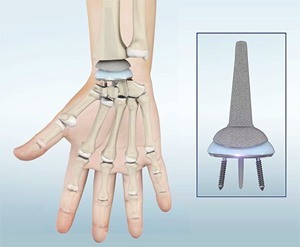Wrist Joint Replacement

Wrist joint replacement surgery, also referred to as total wrist arthroplasty, involves replacement of a severe arthritic wrist joint with an artificial joint made of metal and plastic components. It relieves pain and restores function when conservative treatment fails to provide relief.
Disease overview and symptoms
The wrist is a complex joint made up of 8 carpal bones aligned in two rows with four bones present in each row. The carpal bones are further connected to 5 metacarpal bones that form the palm of the hand. Each small bone forms a joint with the bone next to it. Thus, the wrist joint is made up of many small joints. The two bones of the forearm, radius and ulna, also form a joint with the first row of carpals.
The ends of all these bones are covered with a white, shiny material called articular cartilage. Articular cartilage is smooth and has a rubbery consistency. It allows the bones in a joint to move smoothly against each other. Injury, infection, and diseases such as osteoarthritis and rheumatoid arthritis can damage or wear out the articular cartilage. This may cause the wrist bones to rub against each other producing pain, stiffness and swelling of the wrist.
Diagnosis
Your doctor diagnoses arthritis of the wrist joint after reviewing your medical history, performing a physical examination, and obtaining X-rays. Additionally, blood tests may also be ordered to confirm the presence of rheumatoid arthritis.
Conservative Treatment
Early treatment is non-surgical and includes:
- Avoiding activities that may aggravate the symptoms,
- Immobilization of the affected wrist in a splint,
- Using NSAIDs (Non-Steroidal Anti-Inflammatory drugs),
- Steroid injections into the wrist joint and
- Performing specific wrist exercises.
Surgical Procedure
If non-surgical treatments are ineffective in relieving symptoms wrist replacement surgery may be considered.
The surgery is performed under general or regional anaesthesia.
- An incision is made over the back of the wrist.
- The tendons are moved away to expose the wrist joint.
- Care is taken while moving the nerves to prevent any nerve damage.
- The damaged joint surfaces of the arm bones are removed with a surgical saw.
- The first row of carpal bones may also be removed.
- The radius bone is hollowed out and a radial component of the prosthesis is fixed inside it with bone cement.
- Depending upon the design of the prosthesis, the carpal component is placed in the remaining row of carpal bones or into the third metacarpal bone of the hand.
- The carpal bones may also be linked or fused together to better fix the carpal component.
- A plastic spacer is then fit between the metal components.
- With the new prosthesis in place the wrist joint is tested through its range of motion, and is irrigated with a sterile saline solution.
- The joint capsule is then sutured together.
- The muscles and tendons are repaired, and put back in place.
- The incision is closed and the wrist is bandaged with a sterile dressing.
- Finally, a cast is applied.
After the Surgery
Your arm will be in a cast for the first few weeks after the surgery and you will be prescribed medications to control any pain. Elevating the wrist on a pillow above heart level while sleeping or sitting will help reduce swelling and discomfort. Once the cast is removed, a splint is put for another few weeks. Physical therapy will also be advised to restore movement to the wrist joint.
Risks and Complications
Although wrist replacement surgery is considered safe, there are certain risks and complications associated with any type of surgical procedure. Some of the risks and complications include infection, fracture of the wrist bone, dislocation of the wrist, damage to the nerves or blood vessels, blood clots (deep vein thrombosis), loosening of the implants, wear of the implant, and failure to relieve pain.
Conclusion
Wrist replacement surgery provides pain relief for patients with severe arthritis of the wrist. It also restores the motion of the wrist to the maximum extent, making it possible to do everyday activities. A wrist replacement usually lasts for about 10 to 15 years. Certain activities that could put extra stress on the new joint or may result in a fall on outstretched hands should be avoided after a wrist replacement.
Other Hand & Wrist List
- Trapeziectomy + LRTI
- Hand Tendon Release
- ORIF
- Vascularized Bone Grafting
- Wrist Ligament Reconstruction
- Total Wrist Arthrodesis
- Tendon Reconstruction
- Microsurgery Nerve Repair/Nerve Grafting
- Arthroscopic Wrist Surgery
- Arthroscopic Ganglion Excision
- Collagenase Injection
- Excision of Tumour
- Fasciectomy
- Carpal Tunnel Release

 Menu
Menu






